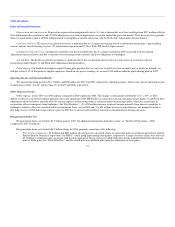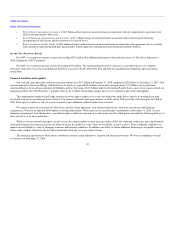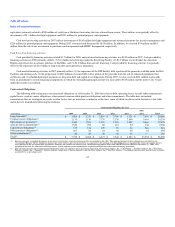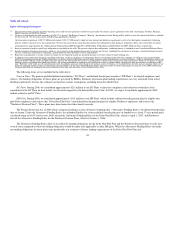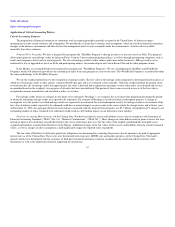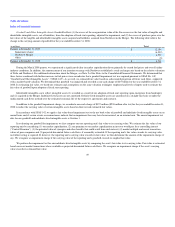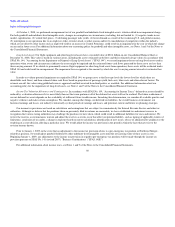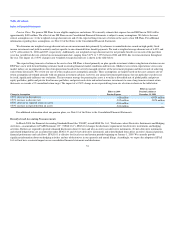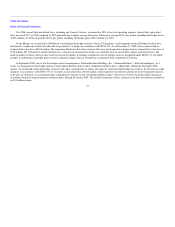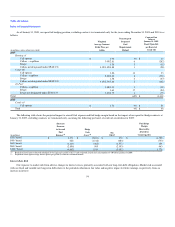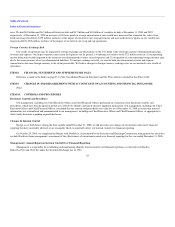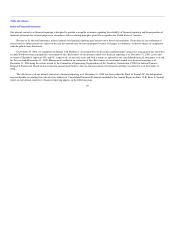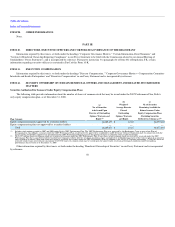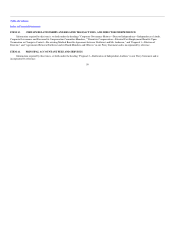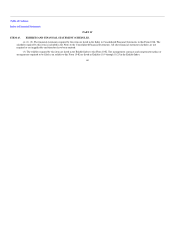Delta Airlines 2008 Annual Report Download - page 55
Download and view the complete annual report
Please find page 55 of the 2008 Delta Airlines annual report below. You can navigate through the pages in the report by either clicking on the pages listed below, or by using the keyword search tool below to find specific information within the annual report.
Table of Contents
Index to Financial Statements
At October 1, 2008, we performed an impairment test of our goodwill and indefinite-lived intangible assets, which resulted in no impairment charge.
For both goodwill and indefinite-lived intangible assets, changes in assumptions or circumstances, including, but not limited to, (1) negative trends in our
market capitalization, (2) volatile fuel prices, (3) declining passenger mile yields, (4) lower demand as a result of the weakening U.S. and global economy,
(5) interruption to our operations due to an employee strike, terrorist attack, or other reasons and/or (6) consolidation of competitors within the industry,
which are not offset by other factors such as improved yield or an increase in Control Premiums, could result in an impairment in the year in which the change
occurs and in future years. For additional information about our accounting policy for goodwill and other intangible assets, see Notes 1 and 5 of the Notes to
the Consolidated Financial Statements.
Long-Lived Assets. Our flight equipment and other long-lived assets have a recorded value of $20.6 billion on our Consolidated Balance Sheet at
December 31, 2008. This value is based on various factors, including the assets' estimated useful lives and their estimated salvage values. In accordance with
SFAS No. 144, "Accounting for the Impairment or Disposal of Long-Lived Assets" ("SFAS 144"), we record impairment losses on long-lived assets used in
operations when events and circumstances indicate the assets might be impaired and the estimated future cash flows generated by those assets are less than
their carrying amounts. If we decide to permanently remove flight equipment or other long-lived assets from operations, these assets will be evaluated under
SFAS 144 and could result in an impairment. The impairment loss recognized is the amount by which the asset's carrying amount exceeds its estimated fair
value.
In order to evaluate potential impairment as required by SFAS 144, we group assets at the fleet type level (the lowest level for which there are
identifiable cash flows) and then estimate future cash flows based on projections of passenger yield, fuel costs, labor costs and other relevant factors. We
estimate aircraft fair values using published sources, appraisals and bids received from third parties, as available. For additional information about our
accounting policy for the impairment of long-lived assets, see Notes 1 and 5 of the Notes to the Consolidated Financial Statements.
Income Tax Valuation Allowance and Contingencies. In accordance with SFAS No. 109, "Accounting for Income Taxes," deferred tax assets should be
reduced by a valuation allowance if it is more likely than not that some portion or all of the deferred tax assets will not be realized. The future realization of
our net deferred tax assets depends on the availability of sufficient future taxable income. In making this determination, we consider all available positive and
negative evidence and make certain assumptions. We consider, among other things, our deferred tax liabilities, the overall business environment, our
historical earnings and losses, our industry's historically cyclical periods of earnings and losses, and potential, current and future tax planning strategies.
Our income tax provisions are based on calculations and assumptions that are subject to examination by the Internal Revenue Service and other tax
authorities. Although we believe that the positions taken on previously filed tax returns are reasonable, we have established tax and interest reserves in
recognition that various taxing authorities may challenge the positions we have taken, which could result in additional liabilities for taxes and interest. We
review the reserves as circumstances warrant and adjust the reserves as events occur that affect our potential liability, such as lapsing of applicable statutes of
limitations, conclusion of tax audits, a change in exposure based on current calculations, identification of new issues, release of administrative guidance or the
rendering of a court decision affecting a particular issue. We would adjust the income tax provision in the period in which the facts that give rise to the
revision become known.
Prior to January 1, 2009, in the event that an adjustment to the income tax provision relates to a pre-emergence tax position or Northwest Merger-
related tax position, we would adjust goodwill followed by other indefinite-lived intangible assets until the net carrying value of these assets is zero.
Beginning January 1, 2009, any adjustments to the income tax provision in regard to pre-emergence tax positions will be made through the income tax
provision pursuant to SFAS No. 141 (revised 2007), "Business Combinations" ("SFAS 141R").
For additional information about income taxes, see Notes 1 and 9 of the Notes to the Consolidated Financial Statements.
50



